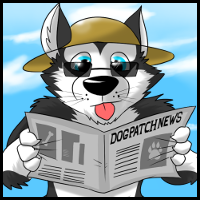My Little Pony: The Art of Equestria – Book Review by Fred Patten
by Pup Matthias
Submitted by Fred Patten, Furry’s favorite historian and reviewer.
 My Little Pony: The Art of Equestria, by Mary Jane Begin. Foreword by Jayson Thiessen. Illustrated.
My Little Pony: The Art of Equestria, by Mary Jane Begin. Foreword by Jayson Thiessen. Illustrated.
NYC, Abrams, October 2015, hardcover $29.95 (215 [+ 1] pages), Kindle $13.49.
Furry fandom has had a sometimes adversarial relationship with the My Little Pony: Friendship Is Magic TV series and its fandom, or at least its Brony often-extremist fans. The TV animated cartoon series that premiered on October 10, 2010 is in its fifth season/year now. It has won the Ursa Major Award as the Best Anthropomorphic Dramatic Short or Series for 2010, 2011, 2012, and 2013, resulting in screams of both (from within furry fandom), “Oh, no! How could it have lost!?” (in 2014, to Furry Force), and (from Brony fandom), “How dare you furry fans try to hijack our program!? MLP:FIM is totally unanthropomorphic! The ponies of Equestria can just talk and sometimes fly, that’s all!”
My Little Pony: The Art of Equestria is an Everything You Want To Know About MLP:FIM, lavish, heavily-illustrated, full-color coffee-table art book. It has already been reviewed and analyzed in detail by the MLP:FIM fans, to general praise. Here is a review for furry fandom.
The book is a how-to and how-it-was-done about the TV animation series and the development of its world of Equestria, rather than an exploration in detail of Equestria and the “Mane Six” ponies, although the reader does get that, too. It begins with a double-page map, described below. A Foreword by the Supervising Director at DHX Media, the animation studio in Vancouver, outlines on one page the basic framework of the series.
“Equestria is a land where the dominant sentient life-forms are derived from the genus Equus – basically, horse-like creatures. Since there are no humans in Equestria, everything that was ever designed or built in this world had to be done by ponies, for ponies. Tables, chairs, doorways, props – all have to work in a way that befits a world existing under this premise. […] There are three basic types of ponies: Unicorns, Pegasus ponies, and Earth ponies. Unicorns, as we all know, are horses with a single horn on their forehead that can cast magic. They are the upper-class elite who live in the mountains. Their cities are made of more robust and expensive materials: stone, granite, and marble. Everything is polished and shiny. Pegasus ponies are winged, they fly and live in the clouds. So their cities are literally made of clouds and are built with fliers in mind: No stairs are needed, and roofs are optional since it doesn’t rain above the clouds. There is a distinctly ancient Greek aesthetic about it, with all the architecture, and this is a nod to the Greek mythological character for which they are named. Finally, there are the Earth ponies, who keep their hooves planted firmly on the ground. They are regular ponies without any fancy appendages who live in more traditional-looking houses and towns like we are used to seeing and deal mostly with earthbound issues such as agriculture and animals. All of this is kept in mind when we’re designing locations to ensure that it feels logical that those characters would actually live I the environment hey are placed in.” (p. 9)
There are seven main parts. “Pony Evolution” is the history of Hasbro’s My Little Pony from 1983, when the toy line was launched, to the present. “Everypony” is a profile of “The Mane Six” characters of today (Twilight Sparkle, Rainbow Dash, Fluttershy, Applejack, Rarity, and Pinkie Pie), and their “extended family: Spike, Princess Celestia, Princess Luna, and the other major characters. “Foils & Foes” describes some recurring villains like Ahuizotl, King Sombra, and Lord Tirek. “Creatures & Mythical Beasts” lists some of the dangerous non-sentient wild animals of Equestria; classic beasts like the Cerberus, Chimera, and Minotaur, and new creations like the Timberwolf (a giant wolf of living wood), Cragadile, and Sea Serpent. “Exploring Equestria” examines some principal cities and towns such as Ponyville, Cloudsdale, the capital of Canterlot, and specific locations like Twilight Sparkle’s Golden Oak Library and Applejack’s Sweet Apple Acres. “Behind the Scenes” is technical information. And “Pony Revolution” looks to the future.

The art includes many artists’ rough sketches, including creator Lauren Faust’s presentation that brought Hasbro’s existing toy line & TV cartoons into the present. There are discarded early designs of some main characters showing what they might have looked like. And there is that double-page map that leads the book off. The series’ developers clearly had fun creating equine-based place names mimicking those around North America, from the metropolises of Manehattan and Filly Delphia on the East Coast to Vanhoover and Los Pegasus in the West, and landmarks such as the San Palomino Desert.
My Little Pony: The Art of Equestria is designed for both the casual fan and the regular watcher of the TV series. “My Little Pony: The Art of Equestria is the ultimate guidebook, collector’s item, and fan keepsake.” (blurb) Well, it should satisfy everyone except the fanatic followers who want an illustrated profile of all 117 (as of press time) episodes.

